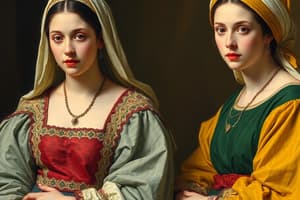Podcast
Questions and Answers
The abaya is exclusively worn by women and is characterized by its long, colorful design.
The abaya is exclusively worn by women and is characterized by its long, colorful design.
False (B)
The kandura is recognized for its colorful and ornate patterns typically associated with festive occasions.
The kandura is recognized for its colorful and ornate patterns typically associated with festive occasions.
False (B)
Natural fibers such as silk and satin are preferred for everyday wear due to their breathability in hot climates.
Natural fibers such as silk and satin are preferred for everyday wear due to their breathability in hot climates.
False (B)
Regional variations in attire are influenced by local customs, with coastal areas favoring more durable materials than desert regions.
Regional variations in attire are influenced by local customs, with coastal areas favoring more durable materials than desert regions.
The bisht serves as a formal outer garment for both men and women during celebrations.
The bisht serves as a formal outer garment for both men and women during celebrations.
Flashcards are hidden until you start studying
Study Notes
Women's Attire
- Abaya: A long, black cloak worn over regular clothes, symbolizes modesty and is often adorned with embellishments.
- Sheila: A headscarf that complements the abaya, usually worn loosely over the hair.
- Bisht: A traditional cloak sometimes worn over the abaya, often made of lightweight fabric, used for formal occasions.
- Kaftan: A loose-fitting dress, often colorful and decorated, popular at festive events and weddings.
Men's Attire
- Ghutra: A traditional headscarf, usually white or checkered, worn to shield from the sun and sand.
- Agal: A black cord used to secure the ghutra on the head.
- Kandura (or Dishdasha): A long white robe worn by men; symbolizes purity and is comfortable in hot weather.
- Bisht: Similar to women, men may wear a bisht as a formal outer garment, often during celebrations.
Cultural Significance
- Clothing reflects Islamic values of modesty and cultural heritage.
- Traditional attire is a marker of national identity and pride for Emiratis.
- Specific styles are often worn during religious celebrations, festivals, and weddings to honor traditions.
Fabric And Materials
- Natural fibers: Cotton and linen for comfort during hot weather.
- Silk and satin: Used for more formal attire and special occasions, enhancing elegance.
- Synthetic fabrics: Gaining popularity for ease of maintenance and variety in styles.
Regional Variations
- Attire may differ slightly between the emirates (Dubai, Abu Dhabi, Sharjah, etc.), influenced by local customs and traditions.
- Women in coastal areas may wear lighter fabrics, while desert dwellers may opt for more durable materials.
- Accessories and embellishments vary, with some regions adopting more modern styles influenced by global fashion trends.
Women's Attire
- Abaya: A long, black cloak worn over regular clothes, often adorned with embellishments. Symbolizes modesty.
- Sheila: A headscarf worn loosely over the hair, complementing the abaya.
- Bisht: A traditional cloak worn over the abaya, often made of lightweight fabric, used for formal occasions.
- Kaftan: A loose-fitting, often colorful dress worn at festive events and weddings.
Men's Attire
- Ghutra: A traditional headscarf, usually white or checkered, worn to shield from the sun and sand.
- Agal: A black cord used to secure the ghutra on the head.
- Kandura (or Dishdasha): A long white robe worn by men, symbolizing purity and comfortable in hot weather.
- Bisht: Similar to women's attire, men may wear a bisht as a formal outer garment, often during celebrations.
Cultural Significance
- Clothing reflects Islamic values of modesty and cultural heritage.
- Traditional attire is a marker of national identity and pride for Emiratis.
- Specific styles are often worn during religious celebrations, festivals, and weddings to honor traditions.
Fabric and Materials
- Natural fibers: Cotton and linen are used for comfort during hot weather.
- Silk and satin: Used for more formal attire and special occasions, enhancing elegance.
- Synthetic fabrics: Gaining popularity for ease of maintenance and variety in styles.
Regional Variations
- Attire may differ slightly between the emirates, influenced by local customs and traditions.
- Women in coastal areas may wear lighter fabrics, while desert dwellers may opt for more durable materials.
- Accessories and embellishments vary, with some regions adopting more modern styles influenced by global fashion trends.
Studying That Suits You
Use AI to generate personalized quizzes and flashcards to suit your learning preferences.




